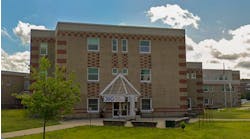Four high-ranking administrators at the University of Central Florida have been fired after an outside investigation found they were involved in the decision to improperly allocate money to replace an aging academic building.
The Orlando Sentinel reports that the investigation concluded that a “broken culture” led the employees to spend $38 million in operating funds to build Trevor Colbourn Hall.
The employees who have been fired: Tracy Clark, associate provost for budget, planning, and administration, and associate vice president for finance; Lee Kernek, associate vice president for facilities and safety; John Pittman, associate vice president for debt and revenue management; and Christy Tant, assistant vice president and university controller.
The university's Board of Trustees also has accepted former President John Hitt’s request to sever ties with the university he led for 26 years until his retirement last year. When he stepped down, he was given a one-year, $300,000 contract as “president emeritus,” a fundraising-focused role.
The terminations came less than a day after release of the investigative report by the Bryan Cave Leighton Paisner law firm. It determined that Central Florida President Dale Whittaker knew the university was using leftover operating funds to build the new academic building, though he said he didn’t know state rules prohibited institutions from using the money that way.
Whittaker says that although the firm concluded that many of those involved in the decision to misuse funds didn’t understand the seriousness of their actions — and no one profited personally — employees have a duty to report unethical or illegal activity. The culture in the administration and finance division, he says, didn’t “place enough value on integrity and competence.”
[Read full statement from UCF President Dale Whittaker.]
The law firm’s investigation was prompted by a finding last year by the state auditor general’s office. In September, university leaders admitted the error.
In all, Whittaker says, the university used, or planned to use, more than $85 million from inappropriate sources on construction.
The law firm’s inquiry concluded Merck, who oversaw the university’s facilities and finance and accounting departments, was a “key figure” in the decision to use leftover operating dollars to build Trevor Colbourn Hall, which opened in August.
And so was Whittaker, the investigators found.
Less than two weeks after he started his tenure as the university’s provost in 2014, Whittaker signed a budget document recommending then-President John Hitt approve using an additional $16 million in leftover operating dollars on the new Trevor Colbourn Hall. His predecessor had already agreed to use $10 million in the same type of funding on the project.
However, investigators doubted whether Whittaker, who served as provost for four years before becoming the university’s president on July 1, knowingly broke state rules.
“We do not believe that Whittaker could have fairly understood the significance of the document he signed in August 2014, since he had just arrived at the university and funding decisions on capital projects are typically not made by the provost,” the report read.


